Report: Leadership, Management, and Operations at Starbucks
VerifiedAdded on 2020/12/10
|16
|4511
|405
Report
AI Summary
This report provides a comprehensive analysis of leadership and management practices within Starbucks, focusing on operations management. It begins by differentiating between leaders and managers, highlighting their distinct traits, roles, responsibilities, and sources of authority. The report then explores the functions of managers, drawing upon the work of Henri Fayol and Mintzberg, and examines the roles of leaders in motivating, supporting, and integrating employees. Furthermore, it delves into various leadership theories, including situational leadership, and examines their practical applications within the context of Starbucks. The report also covers key approaches to operations management and its importance in achieving business goals, offering a well-rounded perspective on the operational strategies that contribute to Starbucks' success. This analysis is designed to provide valuable insights for students studying leadership and management.
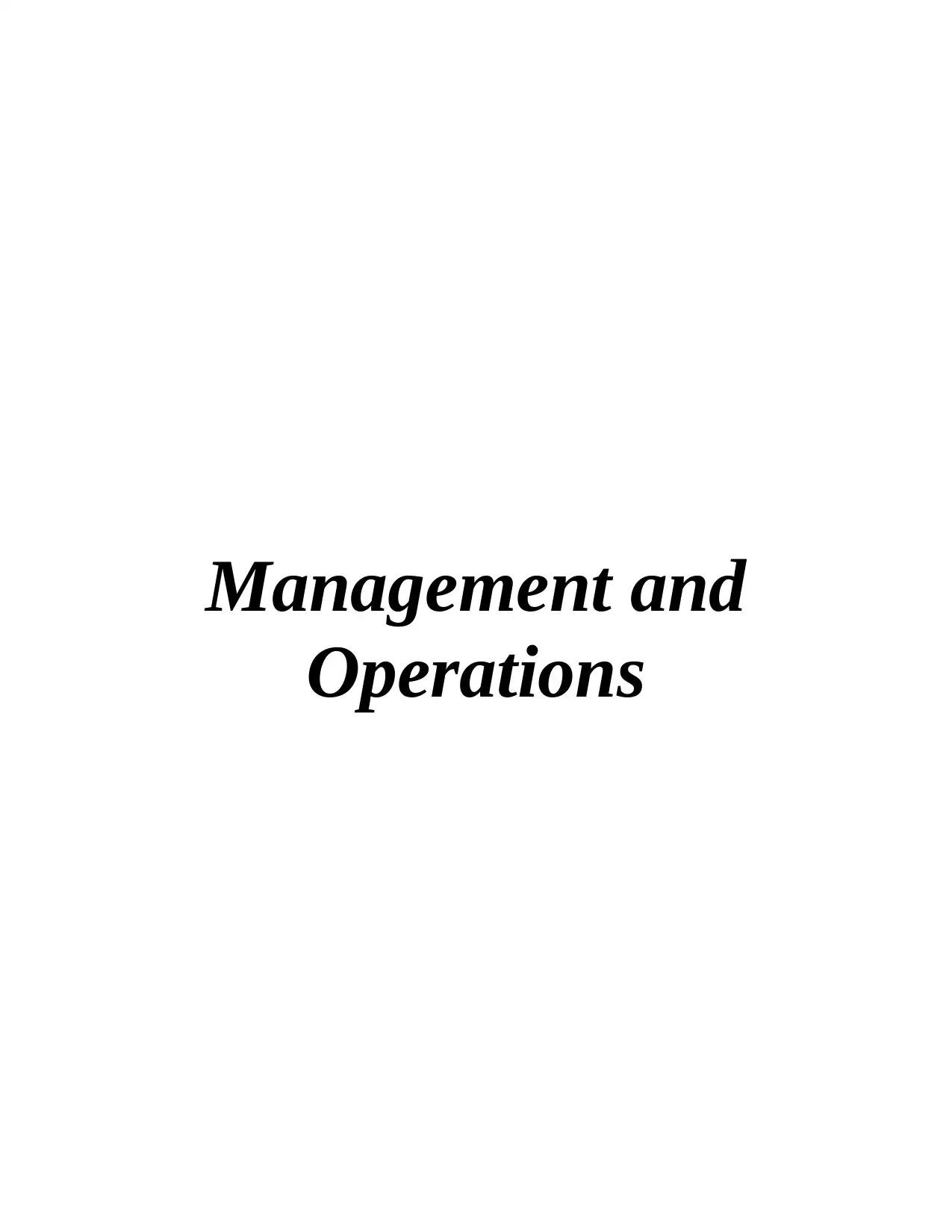
Management and
Operations
Operations
Paraphrase This Document
Need a fresh take? Get an instant paraphrase of this document with our AI Paraphraser
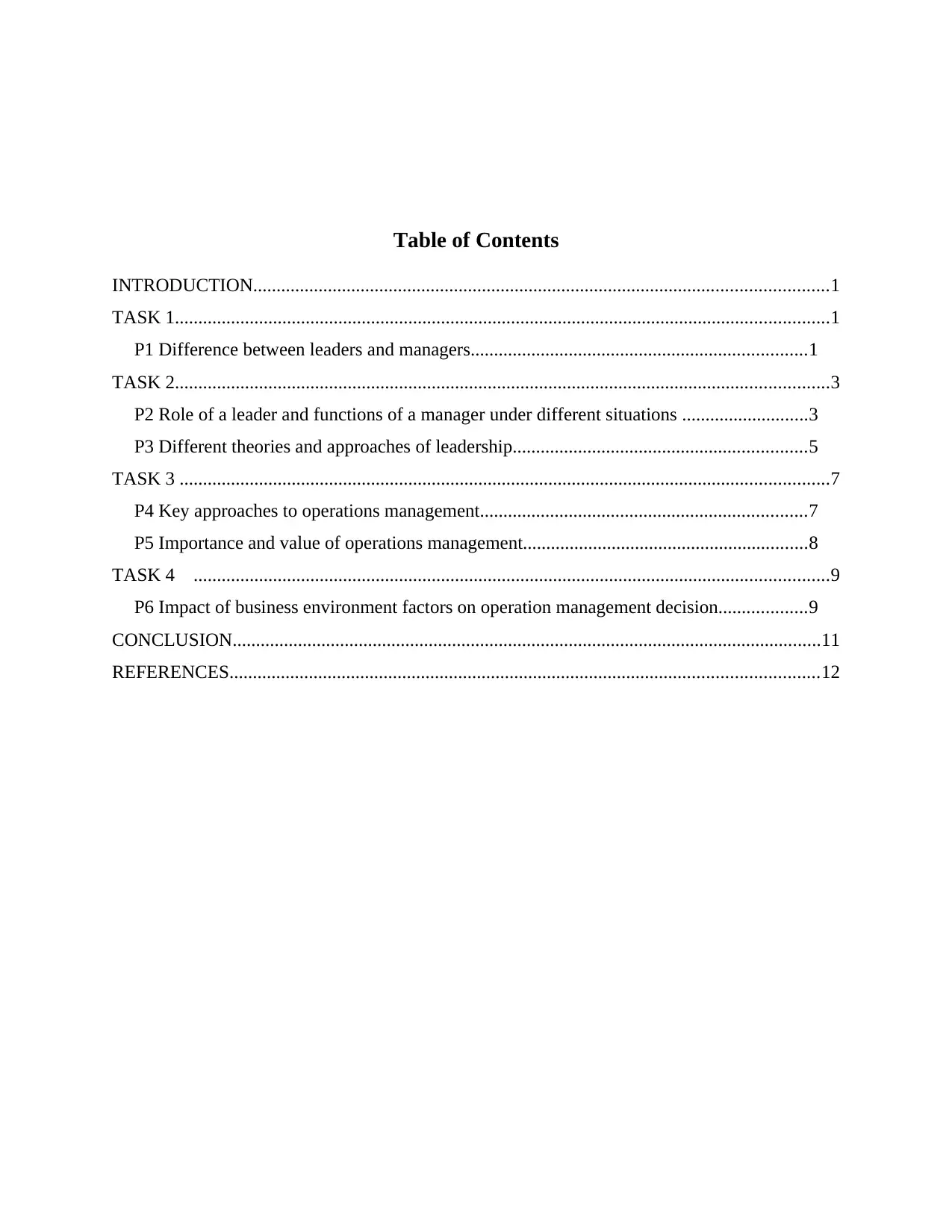
Table of Contents
INTRODUCTION...........................................................................................................................1
TASK 1............................................................................................................................................1
P1 Difference between leaders and managers........................................................................1
TASK 2............................................................................................................................................3
P2 Role of a leader and functions of a manager under different situations ...........................3
P3 Different theories and approaches of leadership...............................................................5
TASK 3 ...........................................................................................................................................7
P4 Key approaches to operations management......................................................................7
P5 Importance and value of operations management.............................................................8
TASK 4 ........................................................................................................................................9
P6 Impact of business environment factors on operation management decision...................9
CONCLUSION..............................................................................................................................11
REFERENCES..............................................................................................................................12
INTRODUCTION...........................................................................................................................1
TASK 1............................................................................................................................................1
P1 Difference between leaders and managers........................................................................1
TASK 2............................................................................................................................................3
P2 Role of a leader and functions of a manager under different situations ...........................3
P3 Different theories and approaches of leadership...............................................................5
TASK 3 ...........................................................................................................................................7
P4 Key approaches to operations management......................................................................7
P5 Importance and value of operations management.............................................................8
TASK 4 ........................................................................................................................................9
P6 Impact of business environment factors on operation management decision...................9
CONCLUSION..............................................................................................................................11
REFERENCES..............................................................................................................................12

⊘ This is a preview!⊘
Do you want full access?
Subscribe today to unlock all pages.

Trusted by 1+ million students worldwide
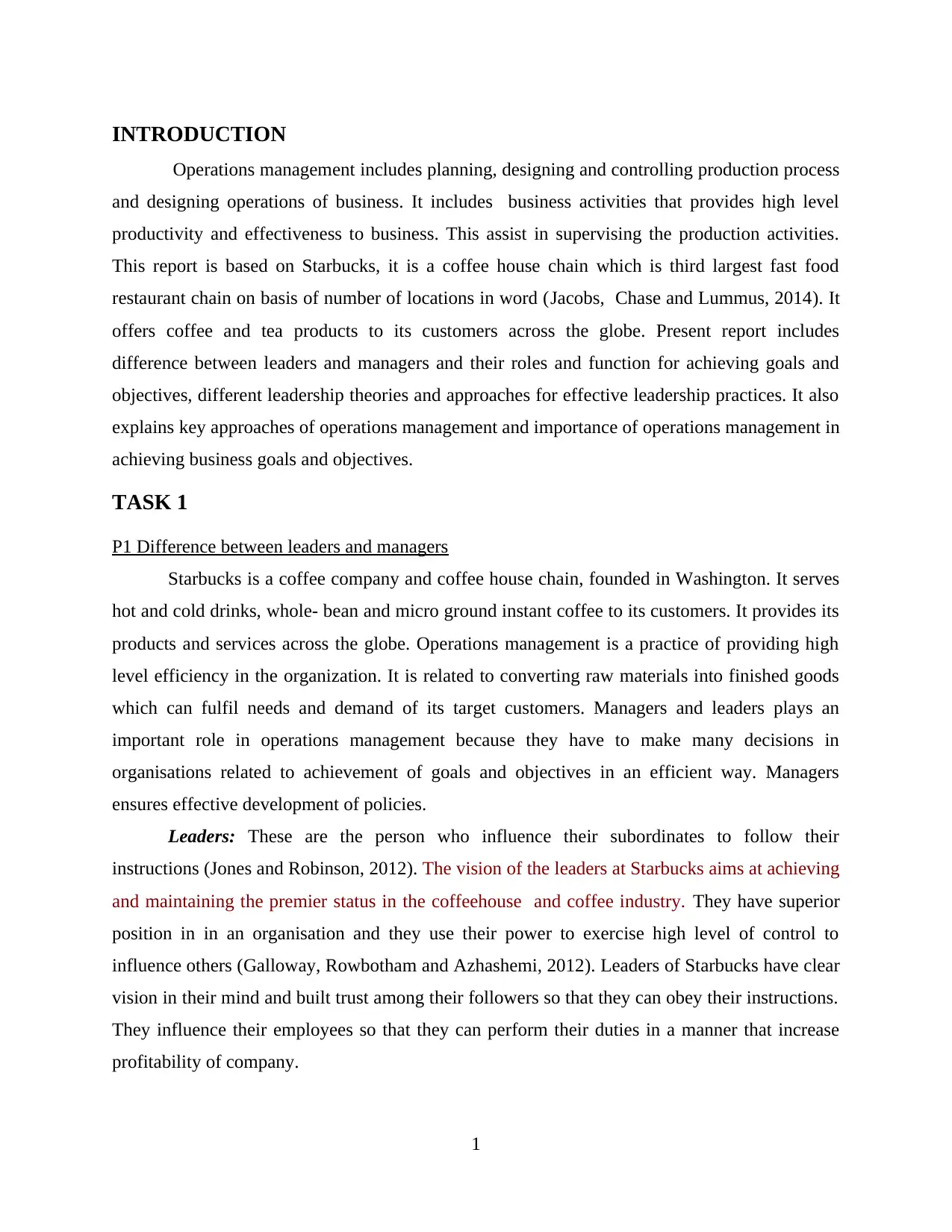
INTRODUCTION
Operations management includes planning, designing and controlling production process
and designing operations of business. It includes business activities that provides high level
productivity and effectiveness to business. This assist in supervising the production activities.
This report is based on Starbucks, it is a coffee house chain which is third largest fast food
restaurant chain on basis of number of locations in word (Jacobs, Chase and Lummus, 2014). It
offers coffee and tea products to its customers across the globe. Present report includes
difference between leaders and managers and their roles and function for achieving goals and
objectives, different leadership theories and approaches for effective leadership practices. It also
explains key approaches of operations management and importance of operations management in
achieving business goals and objectives.
TASK 1
P1 Difference between leaders and managers
Starbucks is a coffee company and coffee house chain, founded in Washington. It serves
hot and cold drinks, whole- bean and micro ground instant coffee to its customers. It provides its
products and services across the globe. Operations management is a practice of providing high
level efficiency in the organization. It is related to converting raw materials into finished goods
which can fulfil needs and demand of its target customers. Managers and leaders plays an
important role in operations management because they have to make many decisions in
organisations related to achievement of goals and objectives in an efficient way. Managers
ensures effective development of policies.
Leaders: These are the person who influence their subordinates to follow their
instructions (Jones and Robinson, 2012). The vision of the leaders at Starbucks aims at achieving
and maintaining the premier status in the coffeehouse and coffee industry. They have superior
position in in an organisation and they use their power to exercise high level of control to
influence others (Galloway, Rowbotham and Azhashemi, 2012). Leaders of Starbucks have clear
vision in their mind and built trust among their followers so that they can obey their instructions.
They influence their employees so that they can perform their duties in a manner that increase
profitability of company.
1
Operations management includes planning, designing and controlling production process
and designing operations of business. It includes business activities that provides high level
productivity and effectiveness to business. This assist in supervising the production activities.
This report is based on Starbucks, it is a coffee house chain which is third largest fast food
restaurant chain on basis of number of locations in word (Jacobs, Chase and Lummus, 2014). It
offers coffee and tea products to its customers across the globe. Present report includes
difference between leaders and managers and their roles and function for achieving goals and
objectives, different leadership theories and approaches for effective leadership practices. It also
explains key approaches of operations management and importance of operations management in
achieving business goals and objectives.
TASK 1
P1 Difference between leaders and managers
Starbucks is a coffee company and coffee house chain, founded in Washington. It serves
hot and cold drinks, whole- bean and micro ground instant coffee to its customers. It provides its
products and services across the globe. Operations management is a practice of providing high
level efficiency in the organization. It is related to converting raw materials into finished goods
which can fulfil needs and demand of its target customers. Managers and leaders plays an
important role in operations management because they have to make many decisions in
organisations related to achievement of goals and objectives in an efficient way. Managers
ensures effective development of policies.
Leaders: These are the person who influence their subordinates to follow their
instructions (Jones and Robinson, 2012). The vision of the leaders at Starbucks aims at achieving
and maintaining the premier status in the coffeehouse and coffee industry. They have superior
position in in an organisation and they use their power to exercise high level of control to
influence others (Galloway, Rowbotham and Azhashemi, 2012). Leaders of Starbucks have clear
vision in their mind and built trust among their followers so that they can obey their instructions.
They influence their employees so that they can perform their duties in a manner that increase
profitability of company.
1
Paraphrase This Document
Need a fresh take? Get an instant paraphrase of this document with our AI Paraphraser

Managers: This kind of person in Starbucks perform activities in their organisation like
planning, organising, controlling and directing for smooth functioning of business activities.
(Bromiley and Rau, 2016) They are accountable for managing and controlling their staff and
they have charge for the task of certain groups. They controls activities and performance of
different departments in company. A company has many managers like functional, line, staff,
project manager and number of managers depends on the size of organisation. (Gunasekaran and
Irani, 2014). For example, the managers of Starbucks wants to increase the sales by 2 %, so here
the manager motivates its employees to work more efficiently by which the production becomes
quick and therefore sales increases.
Leaders and managers of Starbucks both have different styles to perform their task and
duties. Leadership sets a direction and create vision for their followers which they follow to
achieve their objectives ger a(Olhand Johansson, 2012). Managers direct and control members of
groups as per the set standards and principles of company. These both have different roles,
functions, characteristics, power and authority that differentiate them from each other. These
differences are explained as below:
Basis Leaders Managers
Traits They have strong
communication quality,
passion and commitment
towards their work, positive
attitude towards people and
work. They are innovative in
nature as they always focuses
on finding creative solutions to
problems (Bromiley and Rau,
2016).
Managers of Starbucks are self
motivated, people oriented,
focused towards results and
productivity. They delegate
works to subordinates and
create collaboration among
employees.
Roles and responsibilities Leaders of Starbucks provides
training to followers, give clear
They overseeing activities and
performance of their
2
planning, organising, controlling and directing for smooth functioning of business activities.
(Bromiley and Rau, 2016) They are accountable for managing and controlling their staff and
they have charge for the task of certain groups. They controls activities and performance of
different departments in company. A company has many managers like functional, line, staff,
project manager and number of managers depends on the size of organisation. (Gunasekaran and
Irani, 2014). For example, the managers of Starbucks wants to increase the sales by 2 %, so here
the manager motivates its employees to work more efficiently by which the production becomes
quick and therefore sales increases.
Leaders and managers of Starbucks both have different styles to perform their task and
duties. Leadership sets a direction and create vision for their followers which they follow to
achieve their objectives ger a(Olhand Johansson, 2012). Managers direct and control members of
groups as per the set standards and principles of company. These both have different roles,
functions, characteristics, power and authority that differentiate them from each other. These
differences are explained as below:
Basis Leaders Managers
Traits They have strong
communication quality,
passion and commitment
towards their work, positive
attitude towards people and
work. They are innovative in
nature as they always focuses
on finding creative solutions to
problems (Bromiley and Rau,
2016).
Managers of Starbucks are self
motivated, people oriented,
focused towards results and
productivity. They delegate
works to subordinates and
create collaboration among
employees.
Roles and responsibilities Leaders of Starbucks provides
training to followers, give clear
They overseeing activities and
performance of their
2

instruction, communicate with
them, and monitor
performance of employees.
departments, ensure daily
operations, set goals, evaluate
performance of staff for
encouraging productive work.
Authority and power They have powers to reward or
punish an employee through
legitimate, charismatic, expert,
reward, coercive and political
power.
Managers have authority to
hire and fire employees for job
vacancies. They make policies
for reward and punishment for
employees.
TASK 2
P2 Role of a leader and functions of a manager under different situations
It is very essential for managers and leaders of Starbucks to effectively carry out their
duties in different situations. Henri Fayol have described various functions of managers which
are mentioned below: Planning: Planning is the first step of management in Starbucks. Henri Fayol describes
this function as the most important function of an organisation. It helps the managers of
the firm to craft effective strategies which sets base for the operations of the firm.
Achievement of objectives of the firm depends heavily on the planning of its activities. Organizing: After planning, managers move to a detail organising of activities, which
involves organizing various resources for the work (Swink and et. al., 2017). These
resources include the capital for carrying out the tasks, employees who are responsible
for completing the operations, and various other materials necessary to accomplish goals. Commanding: In this step, managers of Starbucks clearly gives out duties to their
employees. They clearly state their roles, responsibilities and a time frame under which
they are required to complete their tasks. This step helps the managers to motivate the
employees and ensure better commitment towards the organisation. Coordinating: Coordination is the essence of management. Henri Fayol describe this
function as a crucial activity required to accomplish the company's goals. It is
coordination which helps an organisation to succeed. Managers at Starbucks are
3
them, and monitor
performance of employees.
departments, ensure daily
operations, set goals, evaluate
performance of staff for
encouraging productive work.
Authority and power They have powers to reward or
punish an employee through
legitimate, charismatic, expert,
reward, coercive and political
power.
Managers have authority to
hire and fire employees for job
vacancies. They make policies
for reward and punishment for
employees.
TASK 2
P2 Role of a leader and functions of a manager under different situations
It is very essential for managers and leaders of Starbucks to effectively carry out their
duties in different situations. Henri Fayol have described various functions of managers which
are mentioned below: Planning: Planning is the first step of management in Starbucks. Henri Fayol describes
this function as the most important function of an organisation. It helps the managers of
the firm to craft effective strategies which sets base for the operations of the firm.
Achievement of objectives of the firm depends heavily on the planning of its activities. Organizing: After planning, managers move to a detail organising of activities, which
involves organizing various resources for the work (Swink and et. al., 2017). These
resources include the capital for carrying out the tasks, employees who are responsible
for completing the operations, and various other materials necessary to accomplish goals. Commanding: In this step, managers of Starbucks clearly gives out duties to their
employees. They clearly state their roles, responsibilities and a time frame under which
they are required to complete their tasks. This step helps the managers to motivate the
employees and ensure better commitment towards the organisation. Coordinating: Coordination is the essence of management. Henri Fayol describe this
function as a crucial activity required to accomplish the company's goals. It is
coordination which helps an organisation to succeed. Managers at Starbucks are
3
⊘ This is a preview!⊘
Do you want full access?
Subscribe today to unlock all pages.

Trusted by 1+ million students worldwide
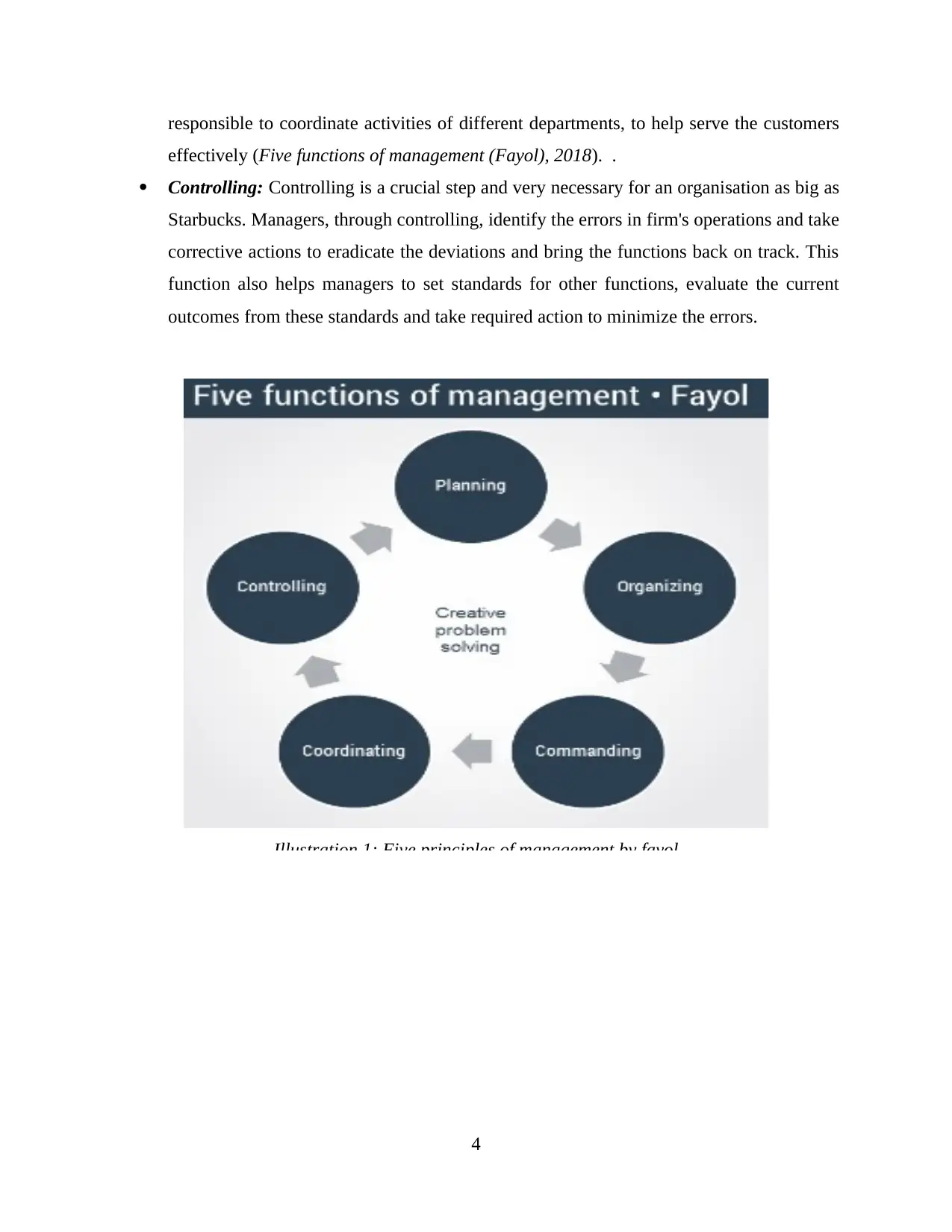
responsible to coordinate activities of different departments, to help serve the customers
effectively (Five functions of management (Fayol), 2018). .
Controlling: Controlling is a crucial step and very necessary for an organisation as big as
Starbucks. Managers, through controlling, identify the errors in firm's operations and take
corrective actions to eradicate the deviations and bring the functions back on track. This
function also helps managers to set standards for other functions, evaluate the current
outcomes from these standards and take required action to minimize the errors.
Illustration 1: Five principles of management by fayol
4
effectively (Five functions of management (Fayol), 2018). .
Controlling: Controlling is a crucial step and very necessary for an organisation as big as
Starbucks. Managers, through controlling, identify the errors in firm's operations and take
corrective actions to eradicate the deviations and bring the functions back on track. This
function also helps managers to set standards for other functions, evaluate the current
outcomes from these standards and take required action to minimize the errors.
Illustration 1: Five principles of management by fayol
4
Paraphrase This Document
Need a fresh take? Get an instant paraphrase of this document with our AI Paraphraser

A leader is a person who influence its team members in achieving their specific goals and
objectives. A manager is a person who controls and manager all business activities with a motive
to increase overall growth of an organisation. In addition to this, situational leadership is a
process in which a leader choose different leadership style to achieve a objective. In this context,
it will helps Starbucks in retaining their productivity for a longer period.
(a) Task structure
In this situation leaders of Starbucks provide basis instruction regarding the task to their
team member in order to achieve their goals and objectives. On the other hand, the function of
managers of Starbucks is to manage various departments of an organisation in order increase its
overall growth. In this context, it will helps Starbucks in generating high profits and in making
their workforce efficient and effective.
(b) Employee relations
In this situation, it is the duty of leaders of Starbucks to guide its team members in
achieving their objectives, which leads in creating a positive work environment in an
organisation. On the other hand, it is the duty of Starbucks manager to established an appropriate
structure for its sub-ordinates and also compensate and punish its employees in accordance with
the work assigned. It will helps Starbucks in making an organisation dynamic in a competitive
business environment.
Functions of managers by Mintzberg: As per professor Mintzberg, who have mentioned that
manager has the following functions.
Interpersonal functions : The first part of this function says that manager at Starbucks is
a figurehead and performs basic ceremonial duties like greeting the visiting dignatories,
arranging lunch for important customers. Second function of the manager is of Starbucks is to
behave like a leader and take up responsibility of the subordinates.
Informational Roles : In this function, manager of Starbucks acts as a monitors which
means he scans the environment and collects the information. The second function performed by
the manager in this part is of a dissemination who passes information from top level to low level.
Decisional role : The first function under this category is of an entrepreneur whose job is
to condition of the unit by initiating new projects. Secondly, Manager of Starbucks also is the
main disturbance handler and looks after all the important matters that cause friction in the
5
objectives. A manager is a person who controls and manager all business activities with a motive
to increase overall growth of an organisation. In addition to this, situational leadership is a
process in which a leader choose different leadership style to achieve a objective. In this context,
it will helps Starbucks in retaining their productivity for a longer period.
(a) Task structure
In this situation leaders of Starbucks provide basis instruction regarding the task to their
team member in order to achieve their goals and objectives. On the other hand, the function of
managers of Starbucks is to manage various departments of an organisation in order increase its
overall growth. In this context, it will helps Starbucks in generating high profits and in making
their workforce efficient and effective.
(b) Employee relations
In this situation, it is the duty of leaders of Starbucks to guide its team members in
achieving their objectives, which leads in creating a positive work environment in an
organisation. On the other hand, it is the duty of Starbucks manager to established an appropriate
structure for its sub-ordinates and also compensate and punish its employees in accordance with
the work assigned. It will helps Starbucks in making an organisation dynamic in a competitive
business environment.
Functions of managers by Mintzberg: As per professor Mintzberg, who have mentioned that
manager has the following functions.
Interpersonal functions : The first part of this function says that manager at Starbucks is
a figurehead and performs basic ceremonial duties like greeting the visiting dignatories,
arranging lunch for important customers. Second function of the manager is of Starbucks is to
behave like a leader and take up responsibility of the subordinates.
Informational Roles : In this function, manager of Starbucks acts as a monitors which
means he scans the environment and collects the information. The second function performed by
the manager in this part is of a dissemination who passes information from top level to low level.
Decisional role : The first function under this category is of an entrepreneur whose job is
to condition of the unit by initiating new projects. Secondly, Manager of Starbucks also is the
main disturbance handler and looks after all the important matters that cause friction in the
5

working. Also he is the main deciding person about the allocation of resources when and what to
bring.
Henceforth, the manager of Starbucks needs to follow these function for the efficient
management and growth of the organisation.
Leaders at Starbucks also play a vital role in influencing the employees to give their
maximum input in achieving the organisation's vision. These roles are: Motivation: The most important role of leaders at Starbucks is to motivate their
employees. This would enhance their performance as their will be more engaged in the
roles they are required to perform. It would also increase the feeling of satisfaction in
employees which ensures better commitment (Gunasekaran and Irani, 2014). Support: Leaders act as a support system for the employees. He is responsible to resolve
their personal as well as professional problems and guides the employees towards
effectively performing their tasks. Also, leaders are responsible to help the employees in
times of pressure.
Integration: Leaders at Starbucks use a perfect blend of leadership traits and integrate the
personal goals of the employees with that of the organisation. They coordinate efforts of
the employees towards the vision of the organisations and thereby attain organisational
objectives.
P3 Different theories and approaches of leadership
Leaders' action are determined or influenced by some theories which determine the way
in which they have to perform their leadership roles (Panneerselvam, 2012). The following are
some theories which determine actions of a leader:
Situational leadership: This model of leadership is given by Paul Hersey and Ken
Blanchard. The main concept behind this theory is that any style of leadership is not the best. For
effective leadership a leader of Starbucks should be task oriented and they have to adopt their
leadership style as per the demands of current situation. For example, if it is rainy season, people
or consumers are more likely to have hot beverages and coffee as compared to cold milkshakes.
Hersey and Blanchard has given the following primary leadership styles:
Telling: In this leadership style leaders tell their followers what they have to do and how
to do the task or job. It is directive and authoritative leadership approach. As leaders make
6
bring.
Henceforth, the manager of Starbucks needs to follow these function for the efficient
management and growth of the organisation.
Leaders at Starbucks also play a vital role in influencing the employees to give their
maximum input in achieving the organisation's vision. These roles are: Motivation: The most important role of leaders at Starbucks is to motivate their
employees. This would enhance their performance as their will be more engaged in the
roles they are required to perform. It would also increase the feeling of satisfaction in
employees which ensures better commitment (Gunasekaran and Irani, 2014). Support: Leaders act as a support system for the employees. He is responsible to resolve
their personal as well as professional problems and guides the employees towards
effectively performing their tasks. Also, leaders are responsible to help the employees in
times of pressure.
Integration: Leaders at Starbucks use a perfect blend of leadership traits and integrate the
personal goals of the employees with that of the organisation. They coordinate efforts of
the employees towards the vision of the organisations and thereby attain organisational
objectives.
P3 Different theories and approaches of leadership
Leaders' action are determined or influenced by some theories which determine the way
in which they have to perform their leadership roles (Panneerselvam, 2012). The following are
some theories which determine actions of a leader:
Situational leadership: This model of leadership is given by Paul Hersey and Ken
Blanchard. The main concept behind this theory is that any style of leadership is not the best. For
effective leadership a leader of Starbucks should be task oriented and they have to adopt their
leadership style as per the demands of current situation. For example, if it is rainy season, people
or consumers are more likely to have hot beverages and coffee as compared to cold milkshakes.
Hersey and Blanchard has given the following primary leadership styles:
Telling: In this leadership style leaders tell their followers what they have to do and how
to do the task or job. It is directive and authoritative leadership approach. As leaders make
6
⊘ This is a preview!⊘
Do you want full access?
Subscribe today to unlock all pages.

Trusted by 1+ million students worldwide

decision then tell this to employees. For example, the managers at Starbucks take the decision of
changing or replacing any product and inform it later to its employees.
Selling: Leaders provides directions and make two way communication with employees,
they perform high directive and supportive behaviour. In this the leaders at Starbucks give
directions to the subordinates about how to practice upselling skills.
Participating: In this leaders of Starbucks has less direction role and permits their
followers to make decisions and provides opportunity to employees to share their ideas and
views for better decision making. For example, the junior subordinates of Starbucks are given an
opportunity to train the newly appointed staff and also provide ideas for improvement in the
various strategies.
Delegating: Leaders gives full authority to team members for decision making, they only
overseeing their work. Employees have whole responsibility for their decisions. In this leader
have low directive and supportive behaviours. For example, the management of Starbucks give
full authority to the middle management to train the subordinates and explain them about the
working conditions. (Brown and Bessant, 2014).
Apart from these leadership styles, this theory includes four maturity levels explained as
follows:
System leadership: This leadership style authorize leaders of Starbucks to manage or
create healthy working environment and conditions. In which all employees can perform their
roles and responsibilities for increasing productivity and profitability by utilizing their full
potential. It helps leaders to create a system in which employees can deliver their effective and
productive behaviour (Vanov, Tsipoulanidis and Schönberger, 2017). This theory emphasizes on
providing development opportunities to all employees so that they can help business to grow. It
also helps Starbucks in achieving sustainability development as their leaders plan their actions to
achieve goals.
Contingency leadership: This theory explains that effectiveness of leaders in Starbucks
depends on the situation as how efficiently they manage and control it. Leaders' decisions and
approaches depends on internal and external situations of business environment. As per this
leadership style there are two types of leaders, task and relationship oriented. Task oriented
leadership are focused towards productivity and are highly concerned for their tasks.
7
changing or replacing any product and inform it later to its employees.
Selling: Leaders provides directions and make two way communication with employees,
they perform high directive and supportive behaviour. In this the leaders at Starbucks give
directions to the subordinates about how to practice upselling skills.
Participating: In this leaders of Starbucks has less direction role and permits their
followers to make decisions and provides opportunity to employees to share their ideas and
views for better decision making. For example, the junior subordinates of Starbucks are given an
opportunity to train the newly appointed staff and also provide ideas for improvement in the
various strategies.
Delegating: Leaders gives full authority to team members for decision making, they only
overseeing their work. Employees have whole responsibility for their decisions. In this leader
have low directive and supportive behaviours. For example, the management of Starbucks give
full authority to the middle management to train the subordinates and explain them about the
working conditions. (Brown and Bessant, 2014).
Apart from these leadership styles, this theory includes four maturity levels explained as
follows:
System leadership: This leadership style authorize leaders of Starbucks to manage or
create healthy working environment and conditions. In which all employees can perform their
roles and responsibilities for increasing productivity and profitability by utilizing their full
potential. It helps leaders to create a system in which employees can deliver their effective and
productive behaviour (Vanov, Tsipoulanidis and Schönberger, 2017). This theory emphasizes on
providing development opportunities to all employees so that they can help business to grow. It
also helps Starbucks in achieving sustainability development as their leaders plan their actions to
achieve goals.
Contingency leadership: This theory explains that effectiveness of leaders in Starbucks
depends on the situation as how efficiently they manage and control it. Leaders' decisions and
approaches depends on internal and external situations of business environment. As per this
leadership style there are two types of leaders, task and relationship oriented. Task oriented
leadership are focused towards productivity and are highly concerned for their tasks.
7
Paraphrase This Document
Need a fresh take? Get an instant paraphrase of this document with our AI Paraphraser
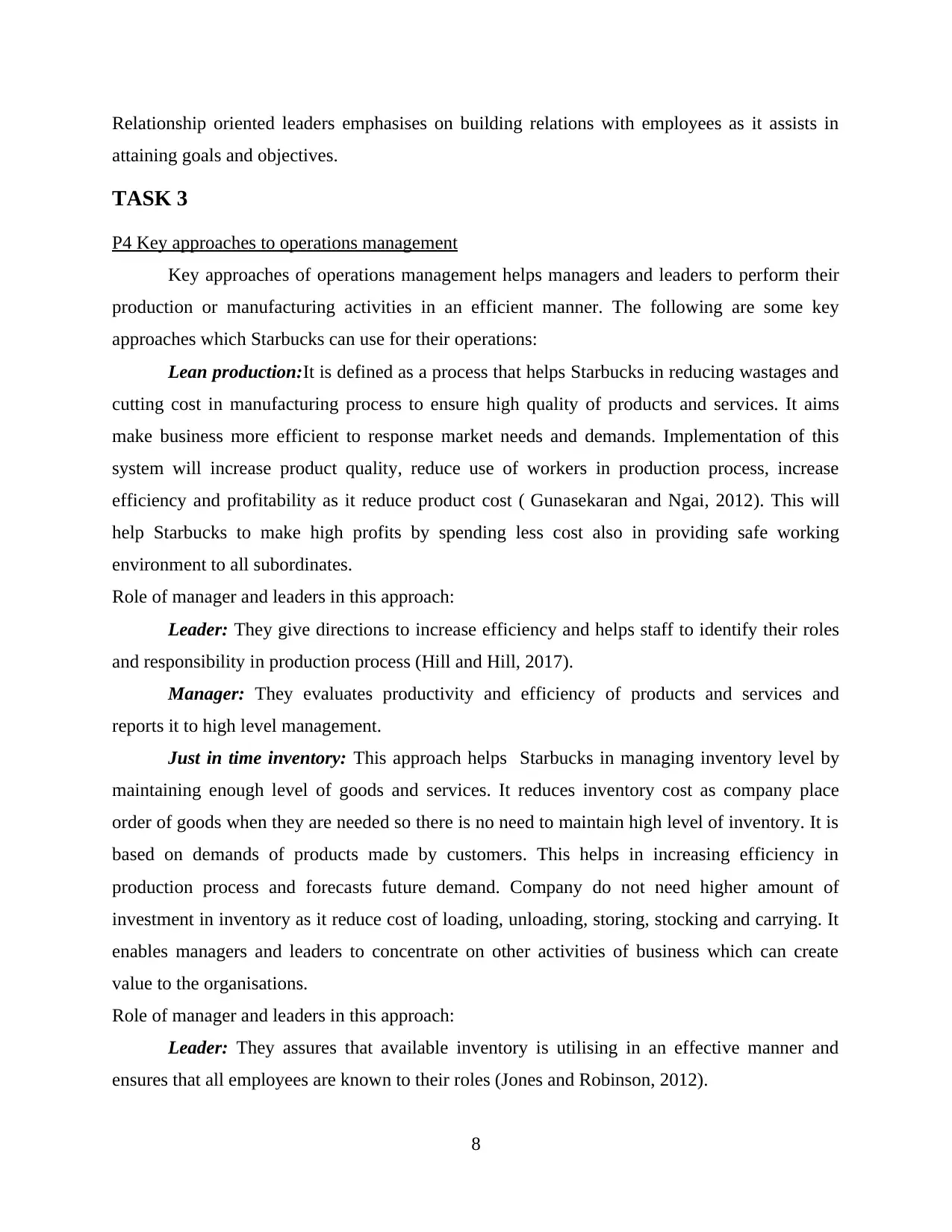
Relationship oriented leaders emphasises on building relations with employees as it assists in
attaining goals and objectives.
TASK 3
P4 Key approaches to operations management
Key approaches of operations management helps managers and leaders to perform their
production or manufacturing activities in an efficient manner. The following are some key
approaches which Starbucks can use for their operations:
Lean production:It is defined as a process that helps Starbucks in reducing wastages and
cutting cost in manufacturing process to ensure high quality of products and services. It aims
make business more efficient to response market needs and demands. Implementation of this
system will increase product quality, reduce use of workers in production process, increase
efficiency and profitability as it reduce product cost ( Gunasekaran and Ngai, 2012). This will
help Starbucks to make high profits by spending less cost also in providing safe working
environment to all subordinates.
Role of manager and leaders in this approach:
Leader: They give directions to increase efficiency and helps staff to identify their roles
and responsibility in production process (Hill and Hill, 2017).
Manager: They evaluates productivity and efficiency of products and services and
reports it to high level management.
Just in time inventory: This approach helps Starbucks in managing inventory level by
maintaining enough level of goods and services. It reduces inventory cost as company place
order of goods when they are needed so there is no need to maintain high level of inventory. It is
based on demands of products made by customers. This helps in increasing efficiency in
production process and forecasts future demand. Company do not need higher amount of
investment in inventory as it reduce cost of loading, unloading, storing, stocking and carrying. It
enables managers and leaders to concentrate on other activities of business which can create
value to the organisations.
Role of manager and leaders in this approach:
Leader: They assures that available inventory is utilising in an effective manner and
ensures that all employees are known to their roles (Jones and Robinson, 2012).
8
attaining goals and objectives.
TASK 3
P4 Key approaches to operations management
Key approaches of operations management helps managers and leaders to perform their
production or manufacturing activities in an efficient manner. The following are some key
approaches which Starbucks can use for their operations:
Lean production:It is defined as a process that helps Starbucks in reducing wastages and
cutting cost in manufacturing process to ensure high quality of products and services. It aims
make business more efficient to response market needs and demands. Implementation of this
system will increase product quality, reduce use of workers in production process, increase
efficiency and profitability as it reduce product cost ( Gunasekaran and Ngai, 2012). This will
help Starbucks to make high profits by spending less cost also in providing safe working
environment to all subordinates.
Role of manager and leaders in this approach:
Leader: They give directions to increase efficiency and helps staff to identify their roles
and responsibility in production process (Hill and Hill, 2017).
Manager: They evaluates productivity and efficiency of products and services and
reports it to high level management.
Just in time inventory: This approach helps Starbucks in managing inventory level by
maintaining enough level of goods and services. It reduces inventory cost as company place
order of goods when they are needed so there is no need to maintain high level of inventory. It is
based on demands of products made by customers. This helps in increasing efficiency in
production process and forecasts future demand. Company do not need higher amount of
investment in inventory as it reduce cost of loading, unloading, storing, stocking and carrying. It
enables managers and leaders to concentrate on other activities of business which can create
value to the organisations.
Role of manager and leaders in this approach:
Leader: They assures that available inventory is utilising in an effective manner and
ensures that all employees are known to their roles (Jones and Robinson, 2012).
8
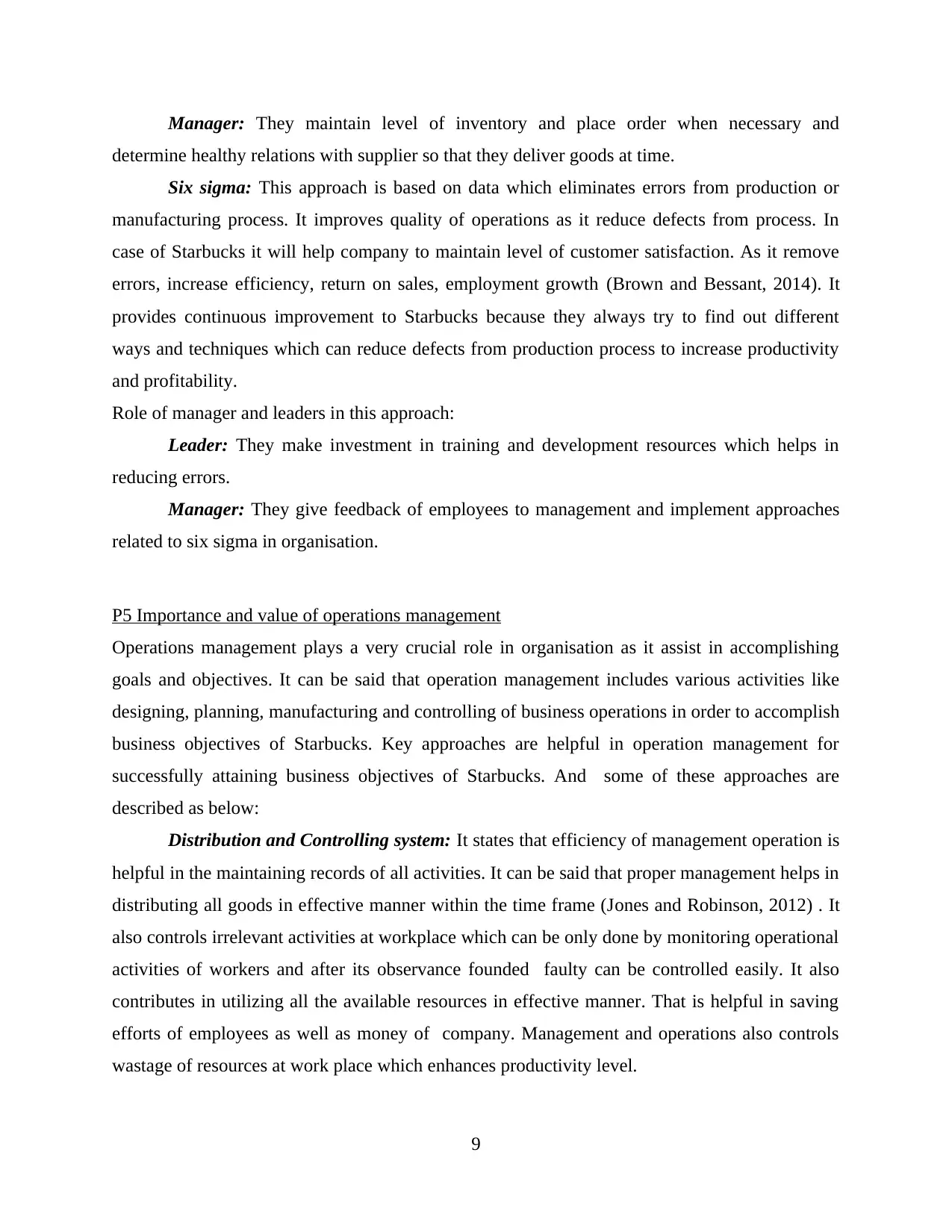
Manager: They maintain level of inventory and place order when necessary and
determine healthy relations with supplier so that they deliver goods at time.
Six sigma: This approach is based on data which eliminates errors from production or
manufacturing process. It improves quality of operations as it reduce defects from process. In
case of Starbucks it will help company to maintain level of customer satisfaction. As it remove
errors, increase efficiency, return on sales, employment growth (Brown and Bessant, 2014). It
provides continuous improvement to Starbucks because they always try to find out different
ways and techniques which can reduce defects from production process to increase productivity
and profitability.
Role of manager and leaders in this approach:
Leader: They make investment in training and development resources which helps in
reducing errors.
Manager: They give feedback of employees to management and implement approaches
related to six sigma in organisation.
P5 Importance and value of operations management
Operations management plays a very crucial role in organisation as it assist in accomplishing
goals and objectives. It can be said that operation management includes various activities like
designing, planning, manufacturing and controlling of business operations in order to accomplish
business objectives of Starbucks. Key approaches are helpful in operation management for
successfully attaining business objectives of Starbucks. And some of these approaches are
described as below:
Distribution and Controlling system: It states that efficiency of management operation is
helpful in the maintaining records of all activities. It can be said that proper management helps in
distributing all goods in effective manner within the time frame (Jones and Robinson, 2012) . It
also controls irrelevant activities at workplace which can be only done by monitoring operational
activities of workers and after its observance founded faulty can be controlled easily. It also
contributes in utilizing all the available resources in effective manner. That is helpful in saving
efforts of employees as well as money of company. Management and operations also controls
wastage of resources at work place which enhances productivity level.
9
determine healthy relations with supplier so that they deliver goods at time.
Six sigma: This approach is based on data which eliminates errors from production or
manufacturing process. It improves quality of operations as it reduce defects from process. In
case of Starbucks it will help company to maintain level of customer satisfaction. As it remove
errors, increase efficiency, return on sales, employment growth (Brown and Bessant, 2014). It
provides continuous improvement to Starbucks because they always try to find out different
ways and techniques which can reduce defects from production process to increase productivity
and profitability.
Role of manager and leaders in this approach:
Leader: They make investment in training and development resources which helps in
reducing errors.
Manager: They give feedback of employees to management and implement approaches
related to six sigma in organisation.
P5 Importance and value of operations management
Operations management plays a very crucial role in organisation as it assist in accomplishing
goals and objectives. It can be said that operation management includes various activities like
designing, planning, manufacturing and controlling of business operations in order to accomplish
business objectives of Starbucks. Key approaches are helpful in operation management for
successfully attaining business objectives of Starbucks. And some of these approaches are
described as below:
Distribution and Controlling system: It states that efficiency of management operation is
helpful in the maintaining records of all activities. It can be said that proper management helps in
distributing all goods in effective manner within the time frame (Jones and Robinson, 2012) . It
also controls irrelevant activities at workplace which can be only done by monitoring operational
activities of workers and after its observance founded faulty can be controlled easily. It also
contributes in utilizing all the available resources in effective manner. That is helpful in saving
efforts of employees as well as money of company. Management and operations also controls
wastage of resources at work place which enhances productivity level.
9
⊘ This is a preview!⊘
Do you want full access?
Subscribe today to unlock all pages.

Trusted by 1+ million students worldwide
1 out of 16
Related Documents
Your All-in-One AI-Powered Toolkit for Academic Success.
+13062052269
info@desklib.com
Available 24*7 on WhatsApp / Email
![[object Object]](/_next/static/media/star-bottom.7253800d.svg)
Unlock your academic potential
Copyright © 2020–2025 A2Z Services. All Rights Reserved. Developed and managed by ZUCOL.





